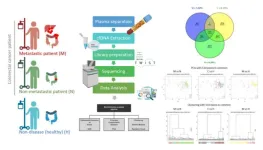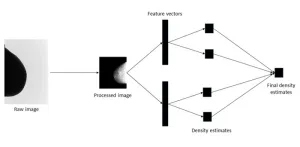(Press-News.org)
**Note: the release below is a special early release from the European Congress of Clinical Microbiology & Infectious Diseases (ECCMID 2023, Copenhagen, 15-18 April). Please credit the conference if you use this story**
Embargo: 2301H UK time Sunday 9 April
**Note – the press release is available in Spanish and Portuguese, see links below**
Targeted testing for HIV in emergency departments has great potential for increasing diagnoses, this year’s European Congress of Clinical Microbiology & Infectious Diseases (ECCMID) in Copenhagen, Denmark, (15-18 April), will hear.
An analysis of data from 34 emergency departments (ED) in Spain found that the number of HIV diagnoses more than trebled after targeted testing was implemented.
Researcher Dr Juan González del Castillo, head of the Infectious Disease Group of Spanish Emergency Medicine Society (SEMES), says: “Early diagnosis is key to avoiding the spread of HIV infection and improving patients’ prognosis but rates of undiagnosed and late-diagnosed infections are still high.
“An estimated 20% of infected people globally do not know they are living with HIV and late diagnosis rates are close to 50% in the developed world. In Spain, the figure is 48%.
“Screening for HIV in hospital emergency departments could increase the number of diagnoses, as well as allow more cases to be detected earlier.”
Guidance released by SEMES in 20211,2 recommends the promotion of HIV testing and referral to appropriate specialists for follow-up in individuals attending emergency departments (ED) for treatment related to one of six conditions or behaviours: sexually transmitted infections (STI), mononucleosic syndrome (MN), herpes zoster virus (HZ), community-acquired pneumonia (CAP), practice of chemsex (CS) and HIV post-exposure prophylaxis (PEP). These are common in people with HIV and are also frequently seen in ED.
In this longitudinal study, Dr González del Castillo, head of the emergency department at Hospital Clínico San Carlos, Madrid, Spain, and colleagues used administrative data and medical charts from 34 Spanish EDs (13% of the national network) participating in the Dejatuhuella (Leave your mark) programme to evaluate levels of HIV testing before (July-Dec 2019) and after (Jan to June 2022) the SEMES guidance was implemented.
The number of HIV tests ordered in ED increased from 7,080 to 13,436. This represents an increase of 75%, when differences in the number of people attending ED are taken into account.
The number of HIV diagnoses increased more than three-fold, from 65 to 224. This represents an increase of 220%, when ED attendance figures are factored in.
The positive test rate increased from 0.92% to 1.67%. This was expected, as previous studies had shown a high positive rate in the six conditions and behaviours covered by the SEMES recommendations.
There was a significant increase in HIV testing in all of the recommended areas, apart from practice of chemsex. STI (36% of patients tested for HIV before implementation vs. 67% after implementation), MS (27% vs. 51%), CAP (7% vs. 21%), HZ (6% vs. 29%), PEP (68% vs 83%). The rate of HIV in CS remained unchanged at 78%.
The demographic and health characteristics of the individuals diagnosed in both periods were similar.
There was a significant reduction in the time between ED attendance and the first appointment with an HIV specialist (median of 30 days vs. 7 days), as well as the initiation of antiviral treatment (median of 24 days vs.14 days).
The study’s authors conclude that the implementation of targeted testing for HIV in emergency departments led to a significant increase in HIV diagnoses.
To date, a total of 103 EDs have implemented the recommendations. Data from SEMES shows that in 2021 and 2022, 113,030 tests were performed, with 287 HIV diagnoses in 2021 and 601 in 2022 –888 new diagnoses in these two years.3 (It isn’t possible to make comparison with earlier years.)
If it is assumed that one diagnosis prevents another two to four cases, the new diagnoses in these two years will have led to 1,756 to 3,512 new cases being avoided.3
Dr González del Castillo says: “We really hope that the Dejatuhuella programme will reverse the downward trend in HIV diagnoses in Spain and reduce the spread of HIV and the high rates of late diagnosis.
“EDs could play a crucial role in HIV diagnosis. We know from previous research that one in three missed opportunities to diagnose HIV occurs in ED and we also know that for many people, their ED is their only point of contact with the healthcare system.
“Increasing the rates of diagnosis and early diagnosis doesn’t just have huge implications for individuals’ health and public health, it would also be cost-effective.
“A recent economic assessment of the SEMES strategy4 calculated that it would prevent 13,615 new infections and have potential savings for the healthcare system of €4,411 million in two decades, with an economic return of €224 per euro invested.”
Targeted screening is one of the two main methods of HIV screening in ED; the other is opt-out screening.
A project in the England is using opt-out HIV testing in A&Es in areas with the highest prevalence of HIV. All adults who are having blood tests while in A&E are tested for HIV unless they opt out. In many areas, hepatitis B and hepatitis C are also tested for.
Data from the 28 A&Es participating in the first 100 days of the project (April to July 2022) shows that more than 250,000 HIV tests were carried out. There were 128 HIV diagnoses, 325 hepatitis B diagnoses and 153 hepatitis C diagnoses.5
“It would be difficult to implement a universal testing strategy like this in Spain, where explicit consent for HIV testing is required,” says Dr González del Castillo. “In addition, some ED physicians may be reluctant to order tests that will not help them diagnose and treat the condition that patient has presented with.
“Targeted HIV screening in the ED, as we are doing in Spain, can be impactful, more cost-effective, and better accepted by both patients and physicians than universal testing.
“On the other hand, we are working on recommendations for hepatitis B and C testing and many EDs have already started doing it at the same time as HIV, with 63 new hepatitis C diagnosis in 2021 and 2022.”
He concludes: “The role that ED can play in HIV detection is pivotal and must be recognised and promoted, whatever the strategy and wherever people are in the world.”
Dr Juan González del Castillo, Head of Infectious Disease Group of Spanish Emergency Medicine Society. Head of Emergency Department, Hospital Clínico San Carlos, Madrid, Spain. T) +34 677654704 E) jgonzalezcast@gmail.com
Alternative contact: Tony Kirby in the ECCMID Media Centre. T) +44 7834 385827 E) tony@tonykirby.com
Notes to editors:
References:
1. http://emergencias.portalsemes.org/descargar/recommendations-for-the-early-diagnosis-of-suspected-human-immunodeficiency-virus-infection-in-the-emergency-department-and-the-referral-of-patients-for-followup-a-consensus-statement-of-the-spanish-society-of-emergency-medicine-semes/english/
2. https://pesquisa.bvsalud.org/portal/resource/pt/ibc-197994
3. https://dejatuhuella.semes.org/
4. https://pubmed.ncbi.nlm.nih.gov/35103440/
5. https://www.england.nhs.uk/long-read/emergency-department-opt-out-testing-for-hiv-hepatitis-b-and-hepatitis-c-the-first-100-days/#:~:text=All%20adults%20attending%20ED%20who,tested%20again%20in%20the%20ED.
The authors declare no conflicts of interest. Gilead funded the study but did not have any role in the study design, its development or the writing of the manuscript.
This press release is based on abstract 3191 at the European Congress of Clinical Microbiology & Infectious Diseases (ECCMID) annual meeting. The material has been peer reviewed by the congress selection committee. The research has been submitted to a medical journal but the full paper is not yet available.
For press release in Spanish click here
For press release in Portuguese click here
END
Targeted testing for HIV in hospital emergency departments has great potential, Spanish researchers say
Strategy led to number of HIV diagnoses increasing more than three-fold
2023-04-10
ELSE PRESS RELEASES FROM THIS DATE:
Engineered plants produce sex perfume to trick pests and replace pesticides
2023-04-10
By using precision gene engineering techniques, researchers at the Earlham Institute in Norwich have been able to turn tobacco plants into solar-powered factories for moth sex pheromones.
Critically, they’ve shown how the production of these molecules can be efficiently managed so as not to hamper normal plant growth.
Pheromones are complex chemicals produced and released by an organism as a means of communication. They allow members of the same species to send signals, which includes letting others know they’re looking for love.
Farmers can hang pheromone dispersers among their crops to mimic the signals ...
Future is bright for gold-based antibiotics
2023-04-08
**Note: the release below is a special early release from the European Congress of Clinical Microbiology & Infectious Diseases (ECCMID 2023, Copenhagen, 15-18 April). Please credit the conference if you use this story**
Embargo: 2301H UK time Friday 7 April
New research being presented at this year’s European Congress of Clinical Microbiology & Infectious Diseases (ECCMID) in Copenhagen, Denmark, (15-18 April) has identified several gold-based compounds with the potential to treat multidrug-resistant “superbugs”.
With ...
How to see the invisible: Using the dark matter distribution to test our cosmological model
2023-04-07
It feels like a classical paradox: How do you see the invisible? But for modern astronomers, it is a very real challenge: How do you measure dark matter, which by definition emits no light?
The answer: You see how it impacts things that you can see. In the case of dark matter, astronomers watch how light from distant galaxies bends around it.
An international team of astrophysicists and cosmologists have spent the past year teasing out the secrets of this elusive material, using sophisticated computer simulations and the observations from the one of the most powerful astronomical cameras in the world, the Hyper Suprime-Cam (HSC). The team is led by astronomers from Princeton ...
Four different autism subtypes identified in brain study
2023-04-07
People with autism spectrum disorder can be classified into four distinct subtypes based on their brain activity and behavior, according to a study from Weill Cornell Medicine investigators.
The study, published March 9 in Nature Neuroscience, leveraged machine learning to analyze newly available neuroimaging data from 299 people with autism and 907 neurotypical people. They found patterns of brain connections linked with behavioral traits in people with autism, such as verbal ability, social affect, and repetitive or stereotypic behaviors. They confirmed that the four autism subgroups could also be replicated in a separate dataset ...
New method of clustering colorectal cancer patients using DPE sequencing
2023-04-07
“[...] DPE analysis may have an important role in improving the diagnosis and management of CRC.”
BUFFALO, NY- April 7, 2023 – A new editorial paper was published in Oncoscience (Volume 10) on March 23, 2023, entitled, “New method of clustering colorectal cancer patients using differential presence of exons (DPE) sequencing.”
Colorectal cancer (CRC) is a heterogeneous disease that occurs in the colon and the rectum, parts of the gastrointestinal system. CRC is the third leading cause of cancer-related ...
Deep learning model estimates cancer risk from breast density
2023-04-07
Breast cancer is the most common cancer to affect women worldwide. According to the American Cancer Society, about 1 in 8 women in the United States will develop breast cancer in their lifetime. While it is not possible to entirely prevent breast cancer, various medical organizations advise regular screening to detect and treat cases at the early stage. The breast density, defined as the proportion of fibro-glandular tissue within the breast, is often used to assess the risk of developing breast cancer. While various methods are available to estimate this measure, studies have shown that subjective assessments conducted by radiologists based on visual analogue scales ...
COVID-19 pandemic increased the frequency of intimate partner violence
2023-04-07
Lesbian, gay, bisexual, transgender and queer people who experienced intimate partner violence in their current relationship before COVID-19 had an increase in the frequency of victimization after the pandemic began, according to a Rutgers study.
While national emergencies, crises and pandemics increase the frequency of health risks and intimate partner violence few studies have considered the nuances of social and psychological factors, such as socioeconomic characteristics and mental health, in explaining the increase in intimate partner violence during times of crisis.
“To date, most programs on intimate ...
Scientists discover a way Earth’s atmosphere cleans itself
2023-04-07
Irvine, Calif., April 7, 2023 — Human activities emit many kinds of pollutants into the air, and without a molecule called hydroxide (OH), many of these pollutants would keep aggregating in the atmosphere.
How OH itself forms in the atmosphere was viewed as a complete story, but in new research published in Proceedings of the National Academy of Sciences, a research team that includes Sergey Nizkorodov, a University of California, Irvine professor of chemistry, report that a strong electric field that exists at the surface between airborne water droplets and ...
Webb reveals never-before-seen details in Cassiopeia A
2023-04-07
The explosion of a star is a dramatic event, but the remains the star leaves behind can be even more dramatic. A new mid-infrared image from NASA’s James Webb Space Telescope provides one stunning example. It shows the supernova remnant Cassiopeia A (Cas A), created by a stellar explosion seen from Earth 340 years ago. Cas A is the youngest known remnant from an exploding, massive star in our galaxy, which makes it a unique opportunity to learn more about how such supernovae occur.
“Cas ...
A new quantum approach to solve electronic structures of complex materials
2023-04-07
If you know the atoms that compose a particular molecule or solid material, the interactions between those atoms can be determined computationally, by solving quantum mechanical equations — at least, if the molecule is small and simple. However, solving these equations, critical for fields from materials engineering to drug design, requires a prohibitively long computational time for complex molecules and materials.
Now, researchers at the U.S. Department of Energy’s (DOE) Argonne National Laboratory and the University of Chicago’s ...
LAST 30 PRESS RELEASES:
Tracing the quick synthesis of an industrially important catalyst
New software sheds light on cancer’s hidden genetic networks
UT Health San Antonio awarded $3 million in CPRIT grants to bolster cancer research and prevention efforts in South Texas
Third symposium spotlights global challenge of new contaminants in China’s fight against pollution
From straw to soil harmony: International team reveals how biochar supercharges carbon-smart farming
Myeloma: How AI is redrawing the map of cancer care
Manhattan E. Charurat, Ph.D., MHS invested as the Homer and Martha Gudelsky Distinguished Professor in Medicine at the University of Maryland School of Medicine
Insilico Medicine’s Pharma.AI Q4 Winter Launch Recap: Revolutionizing drug discovery with cutting-edge AI innovations, accelerating the path to pharmaceutical superintelligence
Nanoplastics have diet-dependent impacts on digestive system health
Brain neuron death occurs throughout life and increases with age, a natural human protein drug may halt neuron death in Alzheimer’s disease
SPIE and CLP announce the recipients of the 2025 Advanced Photonics Young Innovator Award
Lessons from the Caldor Fire’s Christmas Valley ‘Miracle’
Ant societies rose by trading individual protection for collective power
Research reveals how ancient viral DNA shapes early embryonic development
A molecular gatekeeper that controls protein synthesis
New ‘cloaking device’ concept to shield sensitive tech from magnetic fields
Researchers show impact of mountain building and climate change on alpine biodiversity
Study models the transition from Neanderthals to modern humans in Europe
University of Phoenix College of Doctoral Studies releases white paper on AI-driven skilling to reduce burnout and restore worker autonomy
AIs fail at the game of visual “telephone”
The levers for a sustainable food system
Potential changes in US homelessness by ending federal support for housing first programs
Vulnerability of large language models to prompt injection when providing medical advice
Researchers develop new system for high-energy-density, long-life, multi-electron transfer bromine-based flow batteries
Ending federal support for housing first programs could increase U.S. homelessness by 5% in one year, new JAMA study finds
New research uncovers molecular ‘safety switch’ shielding cancers from immune attack
Bacteria resisting viral infection can still sink carbon to ocean floor
Younger biological age may increase depression risk in older women during COVID-19
Bharat Innovates 2026 National Basecamp Showcases India’s Most Promising Deep-Tech Ventures
Here’s what determines whether your income level rises or falls
[Press-News.org] Targeted testing for HIV in hospital emergency departments has great potential, Spanish researchers sayStrategy led to number of HIV diagnoses increasing more than three-fold




